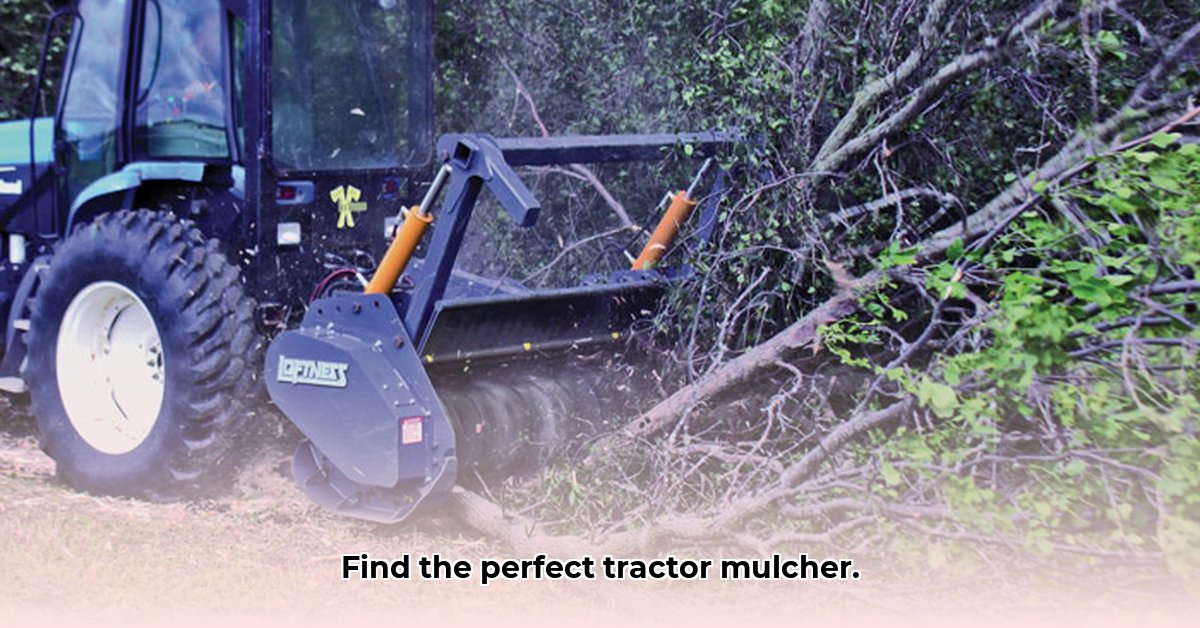
Choosing the right tractor mulcher is a significant investment impacting efficiency and sustainability in land management. This comprehensive guide helps you navigate the selection process, comparing leading brands like FAE and SEPPI, and providing actionable steps for a smart purchase. Whether you're a seasoned farmer or a new landowner, this guide will equip you to make an informed decision. For more tractor implement options, check out this helpful resource.
Understanding Your Needs: Horsepower and Application
Before diving into specific models, honestly assess your land management needs. What type of vegetation are you tackling? Dense shrubs, light undergrowth, or small trees? The density and type of vegetation directly influence the required horsepower. Insufficient horsepower leads to slow operation and potential equipment damage, while excessive horsepower unnecessarily increases initial costs. Always consult your tractor's manual to ensure compatibility with your chosen mulcher. Do you need a machine capable of handling dense forests, or will a smaller model suffice for vineyard maintenance?
Rotor Type: Flail vs. Fixed-Tooth – A Detailed Comparison
Tractor mulchers utilize two primary rotor types: flail and fixed-tooth. Flail rotors, featuring swinging hammers, create a fine mulch ideal for smaller plants and soil preparation. They are well-suited for vineyards and orchards where precise control is needed. Conversely, fixed-tooth rotors excel in handling heavier brush, woody debris, and even small trees, making them preferable for land clearing projects. The choice between these rotor types hinges entirely on your specific application.
Material Matters: Investing in Durability
Durability directly translates to cost savings in the long run. Opt for mulchers constructed from high-strength steel alloys, such as AR400 steel. This robust material significantly enhances lifespan and minimizes maintenance needs. Investing in high-quality materials minimizes downtime and reduces repair costs—a wise long-term investment. How much downtime can your operation afford?
Essential Features: Safety and Efficiency
Several crucial features significantly impact a mulcher's performance and safety. Depth limiters prevent rotor damage by restricting digging depth. Replaceable cutting tools extend the mulcher's lifespan and reduce replacement costs. Robust safety mechanisms—such as shields and safety switches—are non-negotiable for operator protection. Never compromise on safety; it's paramount. What safety features are most crucial for your operation and local regulations?
Budget and Maintenance: A Long-Term Perspective
The cost of tractor mulchers varies widely depending on size, features, and brand. Prices typically begin around $23,760 and can escalate substantially. Beyond the initial investment, incorporate long-term costs such as fuel consumption and regular maintenance into your budget. While a higher-priced, high-quality machine may have a greater upfront cost, it often proves more cost-effective over its lifetime due to reduced maintenance and extended lifespan. How will you finance this investment, and what is your long-term budget for maintenance and fuel?
FAE vs. SEPPI: A Comparative Overview
This section compares two prominent brands, FAE and SEPPI, acknowledging data limitations. Further research may reveal more detailed specifications.
| Feature | FAE | SEPPI | Notes |
|---|---|---|---|
| Horsepower Range | Varies greatly by model | Varies greatly by model | Consult specific model specifications for precise horsepower requirements. |
| Rotor Type | Flail and fixed-tooth available | Flail and fixed-tooth available | The best rotor type depends on your specific application. |
| Material | High-strength steel (Specific grade often unlisted) | Often utilizes AR400 Steel | AR400 steel is generally considered more durable. Verify material specs. |
| Depth Limiter | Availability varies by model | Generally available | A depth limiter is essential for protecting the rotor and preventing damage. |
| Price Range | ~$23,760 and up | ~$23,760 and up | Prices fluctuate significantly; obtain multiple quotes from dealers. |
Step-by-Step Buying Guide: Making an Informed Decision
- Assess Your Needs: Determine the necessary horsepower and appropriate rotor type for your vegetation.
- Research Brands and Models: Thoroughly research various brands and compare specifications based on your needs and budget. Look for independent reviews to gain unbiased feedback.
- Obtain Quotes: Contact multiple dealers to compare pricing and financing options.
- Compare Features: Carefully evaluate safety features, material quality, warranties, and maintenance requirements.
- Make Your Decision: Choose the mulcher that best fulfills your needs and offers optimal long-term value.
Choosing the right tractor mulcher is crucial. Thorough planning ensures you select a machine that enhances your efficiency and contributes to sustainable land management for years to come.